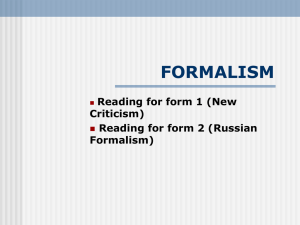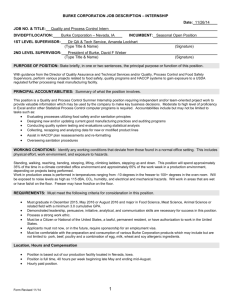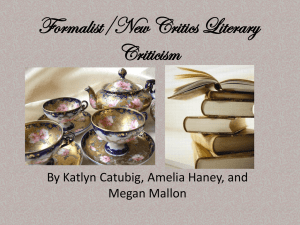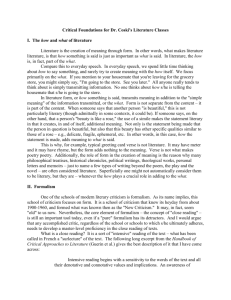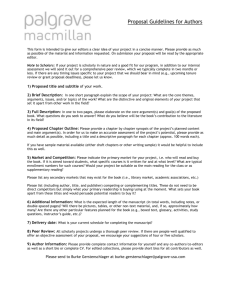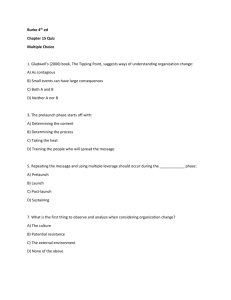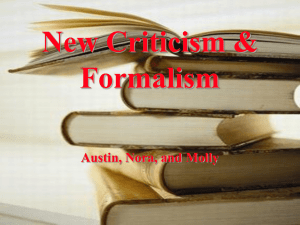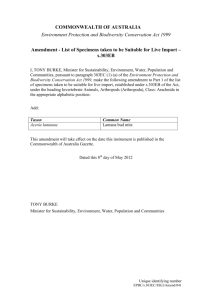of Anglo-American New Criticism, answers this
advertisement
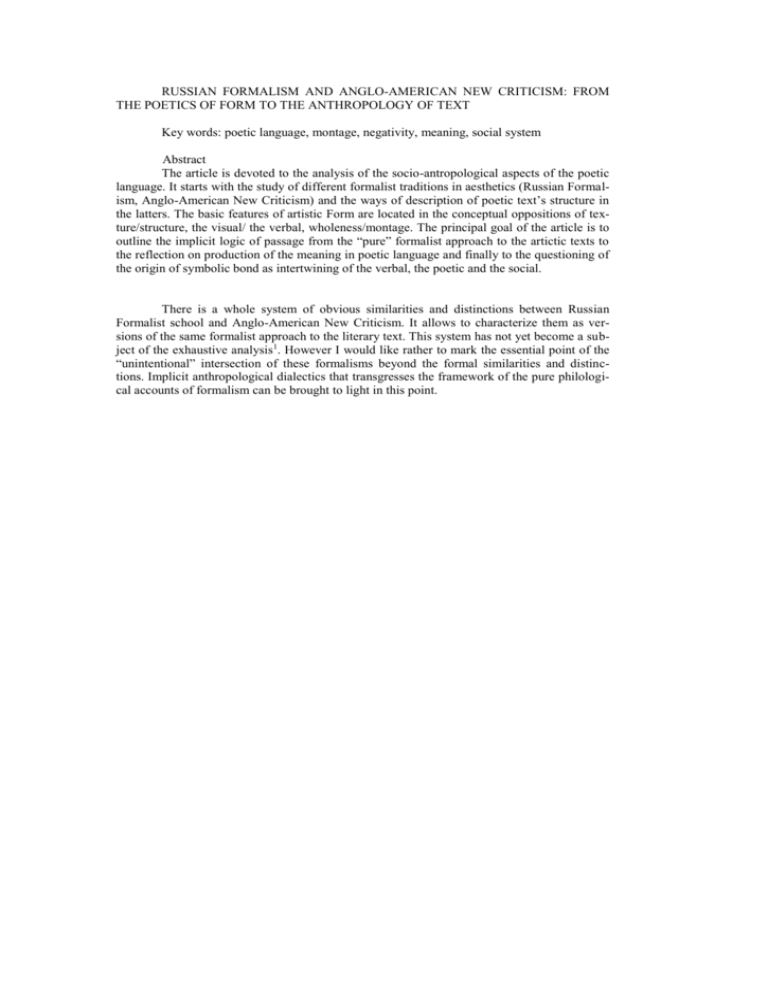
RUSSIAN FORMALISM AND ANGLO-AMERICAN NEW CRITICISM: FROM THE POETICS OF FORM TO THE ANTHROPOLOGY OF TEXT Key words: poetic language, montage, negativity, meaning, social system Abstract The article is devoted to the analysis of the socio-antropological aspects of the poetic language. It starts with the study of different formalist traditions in aesthetics (Russian Formalism, Anglo-American New Criticism) and the ways of description of poetic text’s structure in the latters. The basic features of artistic Form are located in the conceptual oppositions of texture/structure, the visual/ the verbal, wholeness/montage. The principal goal of the article is to outline the implicit logic of passage from the “pure” formalist approach to the artictic texts to the reflection on production of the meaning in poetic language and finally to the questioning of the origin of symbolic bond as intertwining of the verbal, the poetic and the social. There is a whole system of obvious similarities and distinctions between Russian Formalist school and Anglo-American New Criticism. It allows to characterize them as versions of the same formalist approach to the literary text. This system has not yet become a subject of the exhaustive analysis1. However I would like rather to mark the essential point of the “unintentional” intersection of these formalisms beyond the formal similarities and distinctions. Implicit anthropological dialectics that transgresses the framework of the pure philological accounts of formalism can be brought to light in this point. The following paraphrase of the story of formalism can be outlined as an average result of its narrow philological studies. The common initiating moment of the formalism is an attempt to reveal specificity of poetic language as opposed to the ordinary, prosaic communicative language. The most known answers of Russian formalism to the question of the specific features of the poetic language are device and defamiliarization. John Ransom, who can be said of as “Shklovskij” of Anglo-American New Criticism, answers this question in the similar way in terms of “structure / texture” opposition. The structure is formed by the logical totality of the main narrative lines and agencies of the literary work. The texture, on the other hand, consists of all those fine details, indirect associations, heterogeneous elements of the work 2, which make up the “flash” of the latter. So the general aim of the formalist project seems to be elaboration of the poetics of narrative impediments and estrangements that make work tangible, palpable. This poetics is called upon to describe the mystery of the way in which not some authentic things but the very thingness of the thing is given for us in the very surface of the work of art. The destiny of both formalisms is to become the more “scientific” structuralism or to find their second life after death in the various poststructuralist strategies of interpretation. The French philosophers of the text (R. Barthes, J. Derrida, etc.) appear to be a kind of hedonistic postscript to the plot of a formalism sketched above. After all high modernist battles for the “form”, the thesis that texture does not serve as an ornamental addition to the basic narrative or logic structure but contains parallel and incongruous meanings (and this incongruity is necessary to comprehend, to enjoy) became the maxima of postmodernist popular good sense. The form, in the final resort, proves to be that what is avoiding not just unequivocal, schematical understanding, but understanding as such. “Perhaps we prefer the text and not paraphrase…, Ransom writes, – because it is pleasant for us to feel those knots and condensations of language, which resist in it to our understanding” (Ransom: 1984, 198). Here Ransom’s words can be easily mistaken for that of Barthes. It is evident, from the other side, that the new critical technique of the slowed down, “close” reading (to begin with the W. Empson’s analysis of non-reducible “ambiguities” in literary texts (Empson: 1956)) is to the considerable extent analogous with the practices of deconstructivist reading, that allows to speak about the American New criticism as one of sources of the deconstruction. Though Empson himself accused the author of deconstruction, “this horrible Frenchman Jacques Nerrida”, in excessive relativism and turning the meaningful ambiguity into the non-sense3; and other scholars, comparing new critical and deconstructivist strategies of textual analysis emphasized the essential incommensurability of the basic New critical principle of interpretative object’s closure and deconstructivist ideas of openness, multiplicity, and intertextuality of textual meaning (Barzilai S., Bloomfield: 1980, 110-121). I believe that the story of formalism itself bears the open character and possesses a possibility of the different happy end where the analysis of the texture of the artistic form goes beyond the vicious circle of the self-referentiality and lead us to the grasping the text as a socio-anthropological matrix of the individual experience. It is possible to find the question initiating anthropological reflection on text, in one Ransom’s note. Tirelessly fighting against the heresy of paraphrase he unexpectedly asks: “And what we would say of the text, about paraphrase of which we have never thought, and even the need for its paraphrase has never arisen?” (Ransom: 1984, 199). The problem of existence of the text with directly conveyed meaning, the text that does not require special interpretive effort 4 leads us out of the New criticism’s mainstream and places the phenomenon of text in a wide conceptual prospect. I am going to explicate this thesis by focusing on the works of “impossible” (as far as he is not sheer literary critic) New critic Kenneth Burke. But the lens, as it were, for such a focusing I manufactured out of the Russian formalist literary and cinema theory. Here I would like to propose a brief alternative paraphrase – paraphrase that doesn’t heavily draw on the elusive concepts of device and estrangement – of Russian formalism which in the long run via Burke will problematize the ground for the paraphrase as such. Russian formalist theory lays bare, makes perceptible the very interval, gap, montage cut as a positive, productive factor of signification. Russian formalism was set out as a theory of “a new vision” (V. Shklovskij). From the beginning it was oriented toward the point of convergence in which the verbal (poetry) and the visual (cinema) arts reveal their common significative principle – repetition, metaphor, montage. “Ellipsis, or lack – Schklovskij writes, – is basic trope, basic poetic figure (Schklovskij: 1990, 444). Russian formalists have in many ways revealed how and what meanings arise in a productive void between the iterative words. From the early OPOJAZ’s articles of O. Bric, E Polivanov, L. Jackubinskij all the way to J. Tynjanov and B. Eihenbaum’s consceptions of poetic semantics Russian Formalism could be understood as a negative hermeneutics of that meaningful dynamics the trajectories of which are sedimented in the invisible grapheme of the textual meaning (Tynjanov: 1965). The Formalist theory of the cinema is a mirror counterpart of Russian Formalism’s literary theory in this sense. Eihenbaum argues that the cinema viewer performs “the inverse process of reading” (Eihenbaum: 1927, 45): he reconstructed some “internal speech” out of the dynamic images in montage sequence. In a similar way S. Eisenstein puts forward the notion of the montage image (montazhny obraz) as a basic assumption of his theory and practices of cinema. This invisible image is a kind of phenomenological condition of possibility for the things come to be visible in the first place. As platonic ideas are characterized by a condensed thingness in relation to the worldly things, montage images possess some meaningful supervisibility in relation to sheer pictures and are generative matrix of the latters. The verbal (poetic) and the visible (cinematographic) images prove to be the parts of the general synthetic vision early Formalists spelled into existence. In this vision the verbal and the visible mutually generate and substitute each other as in the electro-magnetic field. It has to do with the metaphoric movement of the “passing the distance between the compared and comparing” (V. Shklovskij), the “very passage from one word to another” in the poetic chain according to J. Tynjanov, or cutting from one shot to another in the film (S. Eisenstein). When the cut joins, fuses together – then the image (essentially invisible – “obraz”) arises in between the words, and cinema writing takes place in between the pictures. Properly introduced interval, cut in the Real generates aesthetic form, the plentitude of meaning. The repetition comes into existence at the margins of the cut, articulated Real. The repetition seems to be something quite simple because it surpasses any metalanguage of its description. It is not so much an eternal attempt – as an essential feature of all human projects in the final resort – to reproduce something eventually evading reproduction or expression, no matter whether it belongs to the objects of external world, or internal impressions, or recollections of the such called “past” (which is actually a constitutive part of any moment of the present in the aesthetic scene). Repetition has more to do with the endless production of the ellipses between the repeated and the repeating. In this sense the repetition proves to be both the fundamental feature of the poetic language and the symbolic activity as such. The human life in its symbolic dimension seems to be an extended neurotic effort to repeat meaningfully the life and at the same time – the metaphoric re-production of that very place where the “visible” tetrum comparationis of poetic figures or “invisible” montage image come into being. Only in this aesthetic place or scene human being is able to come to terms with the thing, moreover to grasp the thingness of the thing. And this place ceases to be a kind of transcendental territory suited for the metaphysical speculations if we re-read Kenneth Burke as “impossible formalist” of AngloAmerican New Criticism. From the ambiguity to the negativity this is the crucial conceptual shift, which Burke carries out inside the Anglo-American formalism. Modifying I. Richards’ notion of “psychological balance” Burke describes the dual effect of the symbolic action: the latter constitutes both object and the subject of the perception by means of the equating different qualities. Symbolic things or substantial metaphors are the result of such mergences: the human being aesthetically (archaically, poetically) grasps things without distance, non-oppositionaly. In this essential point Burk’s ideas intersect with the conceptions of “anagogic order” (N. Frye) and “literary symbol” (W. Tindall). Burke’s anthropological universum of the symbolized things corresponds to the anagogic state of the language described by Frye as “absolute order of the words” or Text which combines simultaneously Language and Literature. Burke’s basic presupposition is that the metaphor can be understood as an alternative type (to the that of logic) of verbal coherence that provides us with the initial experience of the world. Metaphor differs from both the logical square’s relation of contrariety, contradictority, complimentarity, and the inclusion of particular term into general term in the logical structure of judgment. The terms of metaphor interpenetrate each other without any domination in the new entity, which is given in a perceptual, visual mode. Moreover the third term of the metaphor comes to be rather the basis than the effect of the two “pre-existed” compared terms in as much as the former is the instance of the unconscious desire of the man through which s/he sees the world. The perceptions of symbolic mergences, according to Burke, affect the identity of the percepting being. They form sub-identities or flexible ground for the Ego-crystallization. The unified ensemble of the sub-identities Burke calls the attitude. The poetry is the most effective means of the unifying quite different elements – from sound and rhythm to meanings and mor- al choices – into textual systems. Equating different impulses, making coherent these “perspectives by incongruity” human being attitudinize itself as the aesthetical body and the moral subject in the symbolic field of culture. “Hence our notion of ‘reality’, - proceeds Burke, amounts to tendentious though unstable complex of personal equations that are implicit in such a simultaneously unique and socially infused ‘orientation’” (Burke: 1984, 394). The conception of the socially infused uniqeness of the work of art lead us to the center of the Burke’s anthropological approach to the poetic text. Analyzing the primitive culture as a poetic medium Burke discovers that what could be described as a paradox of immanence. It means that the fundamental element of the social structure is present in the unique texture of the desire of every member of the archaic group. This kind of social structure is not just an abstract notion but can reveal itself as singular collective body in the moments of intensified reproduction of the social bonds, “collective consubstantiality” during the rite. As in the mediaeval realism the universal (the collective substance) exists neither anti rem (before the members of the group), nor post rem (after the members of the group), but in re (in the every member of the group). The social substance embedded in the very individual “flash” is of the symbolic nature. Firstly, Burke defines the notion of the symbolic as social text, or social-linguistic complex connecting individuals into the web of social relations. Along the Kant-Cassirer lines Burke argues that the reality is a projection of the social text. “Since language derives its material from cooperative act of men in sociopolitical orders, which are themselves held together by a vast network of verbally perfected meanings, might it not follow that man must perceive nature through the fog of symbol-ridden social structures that he has erected atop nature? Material things would thus be like outward manifestations of the forms which are imposed upon intuiting of nature by language, and by the sociopolitical orders that are interwoven with language (…)” (Burke: 1966, 378). But Burke gives us another answer to the question of the nature of the symbolic besides the speculations about the spontaneous arising of the symbolic forms out of the human cooperation. He considers the notions of the social, the verbal and the symbolic to be interchangeable on the basis of specific anthropological negativity. “A specifically symbolic-using animal will necessarily introduce a symbolic ingredient into every experience. Hence every experience will be imbued with negativity. Sheer ‘animality’ is not possible to the sensory experience of a symbol-using animal” (Burke: 1966, 469). The negativity as such cannot be reduced to a particular lack. It is general traumatic experience of the absence as a sum total of the various sexual and economic prohibitions existing within the group. Thus the negativity is treated by Burke not as a metaphysical concept (like in Heidegger’s analysis of the human condition of being pushed into the Nothing) but as Freudo-Marxist category of collective agency of “thou-shalt-not” or the “Tribal No”, as Burke put it. There lies the symbolic origin of linguistic-social system. The symbolic breaches the wall of the Real, punches holes in the perceptive field of the “symbol-using animal”. But these “holes” become the things in their own right. It is not so much a theory of the primordial metaphor as substitution of the tabooed things where the meanings of the substituted and substituting terms are taken as pre-existed as E. Cassirer noted. But if the latter sees the metaphorical nature of the symbolic in the intensification, concentration of the sensual experience lying in the basis of both verbal and mythological-religious symbolism, Burke regards this “concentration” of the sensibility as intensity of the pain or as effect of the positive, aesthetic experience of the negative. Rephrasing L. Mumford statement about the symbolic sanction for the men’s technological tools (Mumford: 1967, 5) – there is nothing human in the fears of the animal before it starts to use symbols. The human being doesn’t merely cope with the animal fears by using symbols. By the same stroke s/he gains both the peculiar human anxiety in front of Nothing and the means of its compensation-reproduction. One can infer from Burke’s argumentation that the origin of the Nothing bears essentially social character that of the group’s ritual self-hurting as the source of the fundamental complex of the sanctity-guilt experienced by the society through the figures of poetic genius or religious mystic. The most dramatic form of this group’s ritual self-hurting is the rites of initiation and sacrifice (or rather elements of one and the same Rite). During the initiation the adolescent become infused, flows into the group, becomes a part of the Supreme Being (totem) through the whole range of the various mutilations, diversely caused feelings of pain and horror. And s/he experienced these pain and horror not as the individual opposed to the hurting group but as the very group given itself aesthetically. On the other hand, the sacrifice or the moment of the awesome admiration of the Supreme Being has a form of cruel torture and slaughter of the Totem (god-group). The form and the content of the archaic ritual messages from group to the individual (constituting auto-communicative social medium) are the corporeal-mythological metaphor: the communal “image” (obraz) of the dance and the world is presented in between the repetitive gestures of the ritual dancersn (Mumford: 1967, 64) 5. L. Mumford in his “The Myth of the Machine” regards this repetitive ritual dance as the most primitive “machine” processing individual neurotism into symbolic forms projected then on the nature. At the same time he notes that the functioning of the “machine” always produces the feeling of guilt as a kind of byproduct and the very artificially repetitive form is analogous to the neurotical experience of popping up of some traumatic core not altogether repressed. But he sees it rather as residue of an original for the human species individual neurotism that was not properly processed in ritual machine. K. Burke as the matter of fact point out that the traumatic core (the lack caused by taboo) is incorporated in the very social substance and the mythological-ritual complex is rather the eternally returning reflection of the social order then the projection of the latter on the threatening chaos of the nature. Mythological “image” (eikon, eidos) of the thing and the verbal metaphor are the two sides of the same ritual entity. There are the traces of that traumatical emptiness that is ciphered mediated by the drawing together and superimposition of the edges of the traumatical cut in the preconscious existence. And the language is this cipher of the lack of the Real. It is in the nothingness as the “substance” of the prohibition the ontological genesis of the things-asgiven-to-human being takes place. The thing, or rather the thingness of the thing in terms of formalist poetics is born there as a superimposition of the primordial metaphor. The human being sees the Mother-Nature and than discerns the mother and the nature out of this third term of the metaphor. He doesn’t just substitute the one existing thing (tabooed women) by the happily found other (the nature, the soil) subliming on it in the forms of (agri)culture or the nonnatural, violent fertilization. The group forces the individual to see in this way any thing in reality. And providing the latter with the possibility to see the objects of desire anywhere (it means in between any insignificant things, or metaphorically), the group compensates for the repression of the prohibited “real” objects. The human being sees in as much as s/he desires, and in as much as human being desires s/he sees such a things like metaphors in the very act of vision closing the circuit of re-production of desire. The Burke’s aspirations to elaborate elements for some synthetic anthropological discipline, combining linguistics, sociology, and literary theory (Burke: 1972) are judged to be unacceptable for the majority of the new critics. For instance, R. Wellek believes that Burke’s analysis goes beyond textual meaning of the poem, its wholeness and coherence that means beyond the basic new critical formalist principle (Wellek: 1963, 354). However Burke carries out the projection of his anthropological ideas on the field of the textual analysis. The poetic text for him is the most authentic form of the primitive, direct communication in modern times. The “direct” here means that the linguistic structure and social texture of the group are presented in the surface of the acts of archaic communication. That what previously functioned in the unique form of the myth in modern times, according to Burke, is splitted into the two quite different discourses – that of the ideology, using hierarchal systems of binary oppositions as the metalanguage of the modeling of ideal society, and the poetry, epitomizing the variety of the metaphorical languages of desire, idiolects, or great modernist styles resisting ideological totalization. The very necessity of the interpretation, endless paraphrases of the text arise as a result of this splitting. The text that knows no need to be interpreted, according to Burke, is the archaic collective poiesis itself. The metaphoricity proves to be both aesthetic and social-anthropological characteristic for the primitive group. «Since social life, – Burke explains, – like art is a problem of appeal, the poetic metaphor would give us invaluable hints for describing modes of practical action which are too often measured by simple tests of utility and too seldom with reference to the communicative, sympathetic, propitiatory factors that are clearly present in those informal arts of living we do not happen to call arts» (Burke: 1954, 264). The world of “contingences”, as Burke calls it, is pre-destined for the human being by means of the metaphor. Contingences are the such contacts of the things, that being quite spontaneous, incidental reveal, however, some deep kinship, community between them that happens to be more meaningful than the each thing separately. Just replace the word “thing” by the “human being” and you get the picture of the archaic collective poiesis. This is he world of the direct communications between men the essence of which is establishing always singular-incidental but essential comm--unity. One human being repeats, echoes another as one term of the metaphor in unpredictable way does for another. The texture of the society is interwoven of these repetitions or “metaphors” functioning in the space of social cooperation. The third term, tetrum comparationis of the metaphor joins together two different words. In the same way men, being the different “terms”, are conjoined on the common basis of cooperative interest. The world of poetry, according to Burke, is the world of the human contacts of things. Burke believes that the economic model of the modern society entails the elimination of the primordial cooperative, communal form of the social interactions. From this perspective poetic language seems to be a container of the pure form of that interactions. The metaphorical dynamics offers “a prompt basis of the wholeness of contingences” (Burke: 1954, 271) that turns out to be the foundation of the collective form in social dimension. There is no room for such a things as “individualism” or dissociation of words in poetry. The words in poetry make sense only being firmly close together to the quality of one super-individual meaningful ensemble6. Some further elaborations of Burks’s formalist analysis (although without explicit anthropological principles) can be found in M. Riffater’s conception of textual meaning. Riffater puts forward the notion of “hypogram” for the designation of that textual meaning. Riffater as formalist considers the literary text (both poetic and prosaic) as consisting of the multi-level system of repetitions (mostly of semantic) in the first place. Hypogram is conceived as an “extended metaphor”, as the common third term in between the whole range of the similar terms or the semantic nucleus that pops up everywhere throughout the text in different verbal forms. For example, in Balzac’s La paix du ménage the hypogram of “all that glitters” is inscribed in the texture of interwoven themes of attractive women, candelabrums, diamonds, etc., and as such expresses the textual meaning of the fatal deception of love in modern times. But Riffater seems to go further this semanticized formalism when he states in Saussurean terms that: “The truth or depth or real function of the text lies in this system of reference and repetition, and not in the content of what is repeated” (Riffater: 1983, 76). The self-referntiality of the text proves to be here something different from notorious formalist treatment of the work of art as closed system. In the final cut the text contains some fundamental external content within its own formal organization. The text refers to the extra-textual but the latter proves to be not the phenomena of non-linguistic reality but their ciphered absence. The text as an extended metaphor conceived not only in semantic plan is the product of the language-system (la langue), introducing the negativity and oppositions. But on the other hand, the text being the system of metaphorical repetitions re-discovering the presence of the intensified, condensed sensible things (Shklovskij’s the “stoneness of the stone”) is a reaction against the language. In the spirit of Burke’s the mediaeval “realist” paradox of substance Riffater treats language as operating outside the text and inside the text in one and the same. The language is only “pre-text (…) whose text appears only by negating it” (Riffater: 1983, 277)7. In sum, the texture, the polysemic associative fabric of the work of art doesn’t remain just the means of the hedonistic sensation of the “world’s body” (J. Ransom). The formalist studies of it lead to the reflection on that order of the words which is situated in “the very center of the social order” (N. Frye). The study of the work of art as the closed system lifted out of any context can be interpreted in the anthropological perspective as modernist gesture of separation of the modern art from the modern society. In as much as the latter preserves the formal matrix of authentic social experience while the former makes the social relations more and more alienated. Explication of the formalism’s paradox of immanence – that of the presentation of the external content in the very formal texture of the work of art (in other words: thingness of the thing is not so much the object as the form of socially molded perception) – allows one to speak of the double function of the negativity as a fundamental philosophicalanthropological principle. In the social-anthropological plan the negativity functions as taboo, prohibition (concerning both sexual and property relationships) imposed upon the individuum from the side of the group. The prohibition is the initial structuring force of the social organization beginning with the matrimonial dualism of the primitive group and elementary property stratification. In the plan of individual existence social prohibition causes the mediation and substitution of the object of desire. As such it would be experienced as a pure traumatic lack unless the aesthetic dimension is a constitutive part of the existential experience of the social being. The ellipsis or omission, cut is a constructive principle of artistic form for the formalists. The indirect naming, reading in between the words, and seeing in between the shots these are the ways by which the human being grasps the objects of desire in all its plentitude in the impossible “place” of the other scene. Ellipsis, montage cut is the aesthetic equivalent of the negativity. In social-anthropological plane the negativity is productive for the developing and stabilization of the social structures but it is repressive in respect to the individual. In the aesthetic plan negativity is positive for the individual’s self-realization as the principle of the artistic vision but in the extremes of “aesthetical immoralism” or l’art pour l’art it can contradicts the social order. The implicit anthropological logic of formalism consists in the pointing out the fundamental complimentarity of those two modalities of the negativity for the phenomenon of man. In the individual self-expressive act assuming the form of the text (elliptical structure or extended metaphor) human being lifts itself out of the average-anonymical level of existence (Heidegger’s das Man). But from the other side, the individual’s social nature is reproduced itself immanently to that textual way s/he discerns itself as singularity. In other words the initial traumatic experience of social prohibition on the other, aesthetic scene is experienced as value. And this value is not only the factor of psychological balancing of the personality and expanding its sensibility by non-excluding contradictory terms as father-founders of AngloAmerican New Criticism I. Richards and W. Empson believed. The aesthetic value of the montage cut is always-already in the deep asymmetric but nevertheless supporting relation to social order as such. Appadurai, A. (1996) Modernity at Large: Cultural Dimensions of Globalization. Ch. 7. Life after primordialism.Minneapolis, London: Univ. of Minnesota Press. References Burke, K. (1954) Permanence and Change. An Anatomy of Purpose. Los-Altos, California: Hermes Publications. Burke, K. (1966) Language as Symbolic Action. Berkeley. Los Angeles: Un. of California Press. Burke, K. (1972) Dramatism and Development. Massachusetts: Clark Un. Press. Burke, K. (1984) Attitudes Toward the History. Los Angeles, London: Un. of California Press. Eihenbaum, B. (1927) ‘Problemy kinostilistiki’, in Poetika kino. Мoscow, Leningrad, 1927. pp. 39-54. Empson, W. (1956) Seven Types of Ambiguity. London: Chatto and Windus. Empson, W. (1987) Argufying: Essays on Literature and Culture. Iowa City: Un. of Iowa Press. Erlich, V. (1981) Russian Formalism: History, Doctrine. New Haven: Yale Un. Press. Gornykh, A. (2002) Formalizm: ot structury k tekstu I za ego predely. Minsk: Logvinov. Jameson, F. (1974) The Prison-house of Language: A Critical Account of Structuralism and Russian Formalism. Princeton, N. J.: Princeton Un. Press. Jameson, F. (1988) The Ideologies of Theory: Essays 1971-1986. Minneapolis: Un. of Minnesota Press. Mumford, L. (1967) The Myth of the Machine: Technics and Human Development. N.Y.: Harcourt, Brace & World inc. Pomorska, K. (1984) The Formalists’ Theory and Its Poetic Ambiance. The HagueParis: Mouton. Ransom, J. (1941) The New Criticism. Norfolk, Connecticut: New Directions. Ransom, J. (1984) Selected Essays. Baton Rougе, London: Lousiana State Un. Press. Riffater, M. (1983) Text Production. N.Y.: Columbia Un. Press. Schklovskij, V. (1990) Gamburgskij schet. Articles – Recollections – Essays (19141933). Moscow: Sovetskij pisatel. Steiner, Р. (1984) Russian Formalism. A Metapoetics. Ithaca, London: Cornell Un. Press. Thompson, E. (1971) Russian Formalism and Anglo-American New Criticism. The Hague-Paris: Mouton. Tynjanov, J. (1965) The problem of the poetic language. Articles. Moscow: Sovetskij pisatel. Wellek, R. (1963) The Main Trends of Twentieth-Century Criticism // Concepts of Criticism. New Haven, London, 1963. Summary The article is devoted to the analysis of the socio-antropological aspects of the poetic language. It starts with the study of different formalist traditions in aesthetics (Russian Formalism, Anglo-American New Criticism) and the ways of description of poetic text’s structure in the latters. The basic features of artistic Form are located in the conceptual oppositions of texture/structure, the visual/ the verbal, wholeness/montage. The principal goal of the article is to outline the implicit logic of passage from the “pure” formalist approach to the artictic texts to the reflection on production of the meaning in poetic language and finally to the questioning of the origin of symbolic bond as intertwining of the verbal, the poetic and the social. РУССКИЙ ФОРМАЛИЗМ И АНГЛО-АМЕРИКАНСКАЯ НОВАЯ КРИТИКА: ОТ ПОЭТИКИ ФОРМЫ К АНТРОПОЛОГИИ ТЕКСТА Статья посвящена анализу социально-антропологических и философскоантропологических аспектов поэтического языка. На материале русской формальной школы и англо-амриканской Новой критики реконструируются основные принципы формального подхода к поэтическому тексту. Базовые харатеристики художественной Формы описываются в ряду концептуальных оппозиций текстура/структура, визуальное/вербальное, целостность/монтаж. Основная цель статья состоит в том, чтобы обозначить имплицитную для самого формализма логику перехода от «чистого» формального подхода к художественному тексту к анализу производства значения в поэтическом языке, и, в конечном счете, к рефлексии по поводу природы символической связи как переплетения вербального, поэтического и социального. The extended analysis of the different “formalisms” see in: Erlich 1981; Stacy 1977; Pomorska 1968; Jameson 1974. E. Thompson’s Russian Formalism and Anglo-American New Criticism (Thompson 1971) is the monograph devoted to the comparative analysis of Russian Formalism and AngloAmerican New Criticism. The analysis of basic implications of the formalist strategy on the material of three “formalisms” – Russian Formalism, Anglo-American New Criticism, and French New Criticism – see in Andrei Gornykh’s Formalism: From Structure to Text and Beyond (Gornykh 2002). 2 For example: “Poem is a complex of sound… a meter, and a musical phrasing which is a texture” (Ransom 1941: 268). 3 In the letter to Ch. Norris from October 7-th, 1971 (Empson 1987). 4 The critical conception of “metacommentary” of the very need for commentary of text see in: Jameson 1988. 5 And that what O. Bric described as “sound repetitions” – a kind of framework of the poetic form for the early Russian formalism – is an autonomized part of the archaic ritual complex. 6 Compare J. Tynjanov’s notion of the “poetic row’s crowdedness (density)” (“tesnota stikhovogo rjada”) as one of the central category of his conception of poetic semantics. 7 Here Riffater uses the insightful Francis Ponge’s pun: “death of the object of desire… of the pretext so that text can arise”. 1
